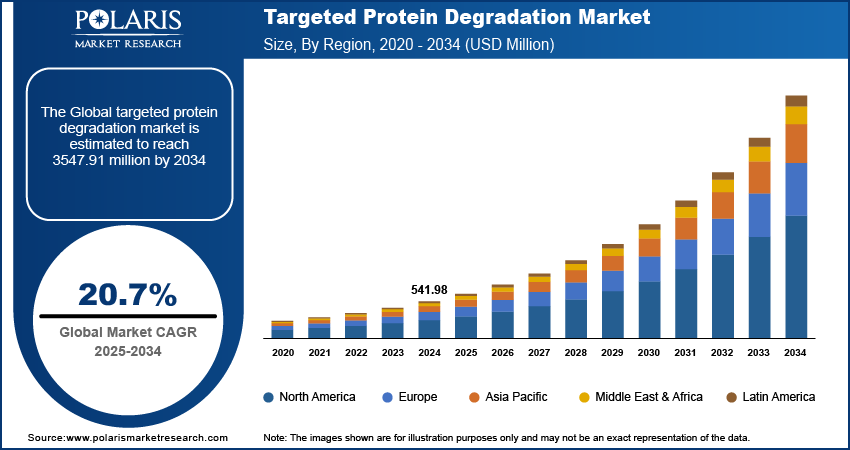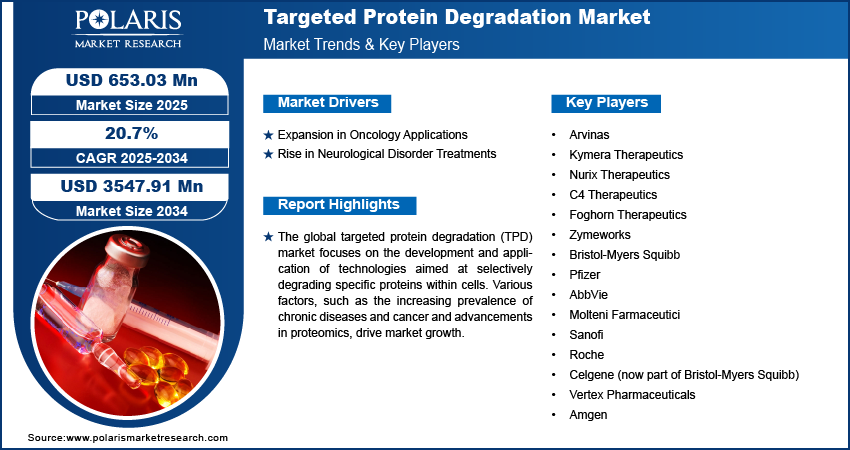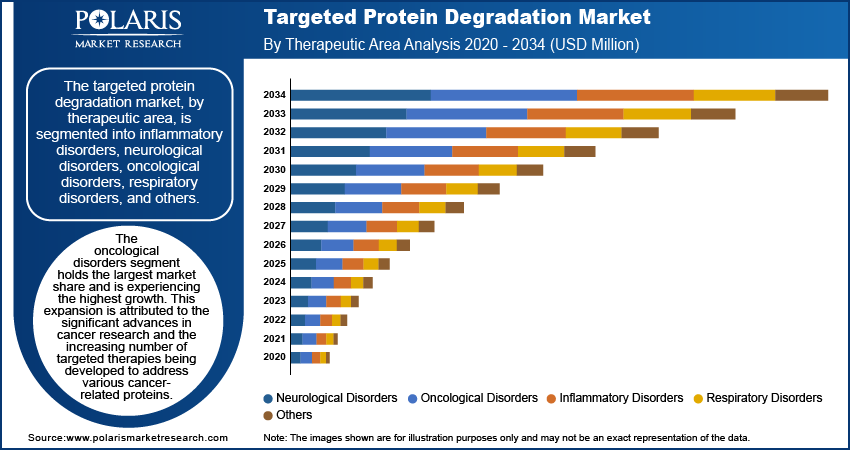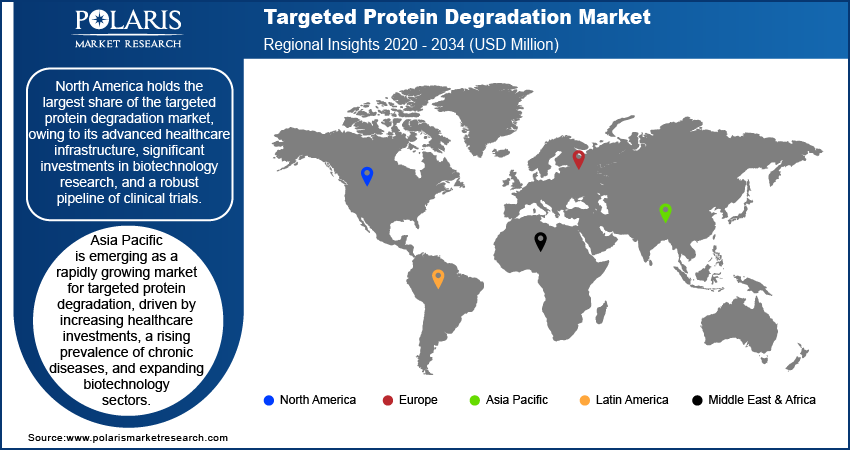
Targeted Protein Degradation Market Size, Share, Trends, Industry Analysis Report: By Type, Therapeutic Area (Inflammatory Disorders, Neurological Disorders, Oncological Disorders, Respiratory Disorders, and Others), Route of Administration, and Region (North America, Europe, Asia Pacific, Latin America, and Middle East & Africa) – Market Forecast, 2025–2034
- Published Date:Nov-2024
- Pages: 116
- Format: PDF
- Report ID: PM5247
- Base Year: 2024
- Historical Data: 2020-2023
Targeted Protein Degradation Market Overview
The global targeted protein degradation market size was valued at USD 541.98 million in 2024. The market is projected to grow from USD 653.03 million in 2025 to USD 3547.91 million by 2034, exhibiting a CAGR of 20.7% during 2025–2034.
The global targeted protein degradation (TPD) market focuses on the development and application of technologies aimed at selectively degrading specific proteins within cells.
This approach is designed to address diseases by targeting and eliminating malfunctioning or disease-causing proteins that traditional therapies may not effectively address. Various factors such as the increasing prevalence of chronic diseases and cancer, advancements in proteomics, and the growing demand for precision medicine drive market growth. Notable future trends include the rising adoption of targeted protein degradation therapies in oncology and neurology and significant investments in research and development to enhance the efficacy and specificity of these treatments.

To Understand More About this Research: Request a Free Sample Report
Targeted Protein Degradation Market Drivers and Trends Analysis
Expansion in Oncology Applications
Targeted protein degradation is emerging as a promising method to address the limitations of traditional cancer therapies; particularly, it is used for targeting oncogenic proteins that drive cancer progression. According to a 2023 study published in Nature Reviews Drug Discovery, ∼60% of the active TPD projects are focused on oncology-related targets. This expansion is driven by the ability of TPD therapies to selectively degrade cancer-related proteins that are difficult to target with conventional drugs. Notable developments include the advancement of proteolysis-targeting chimeras (PROTACs) and other small molecules designed to target specific cancer-associated proteins. These have shown significant potential in preclinical and early clinical trials. Thus, the increasing application of TPD technologies in oncology is expected to emerge as one of the major trends in the targeted protein degradation (TPD) market during the forecast period.
Rise in Neurological Disorder Treatments
There is a growing focus on applying TPD technologies to manage neurological disorders. Proteins implicated in neurodegenerative diseases such as Alzheimer's and Parkinson's are increasingly being targeted for degradation to alleviate disease symptoms or slow progression. A review article in Cell Reports (2023) highlights that more than 20% of recent TPD research initiatives are aimed at neurodegenerative diseases. This trend is supported by the increasing understanding of the role of protein misfolding and aggregation in these conditions. Companies such as Arvinas and Kymera Therapeutics are developing TPD-based therapies specifically for neurodegenerative diseases, demonstrating a significant interest and potential in this area. Thus, the increasing neurological disorder treatment would drive the market growth during 2025–2034.
Strategic Collaborations and Partnerships
Strategic collaborations and partnerships between pharmaceutical companies and biotechnology firms are rapidly increasing in the TPD market. These alliances are crucial for advancing research, sharing technological expertise, and accelerating the development of novel TPD therapies. According to data from BioPharma Dive (2023), there has been a marked rise in partnerships, with over 30 collaborations announced in the past year alone. These partnerships often involve licensing agreements, co-development of new TPD molecules, and joint research initiatives aimed at overcoming technical challenges and optimizing drug delivery systems. This trend underscores the collaborative effort required to bring innovative TPD-based therapeutics from the laboratory to clinical practice.

Targeted Protein Degradation Market Segment Analysis
Targeted Protein Degradation Market Assessment by Type
The targeted protein degradation market, by type, is segmented into degronimids, immunomodulatory drugs (IMiDs), proteolysis-targeting chimeric molecules (PROTACs), sudden acquired retinal degeneration syndrome (SARDs), selective estrogen receptor degraders (SERDs), and others. The proteolysis-targeting chimeric molecules (PROTACs) segment holds the largest market share and is registering the highest growth rate. PROTACs, which leverage bifunctional molecules to direct the degradation of specific proteins, are gaining significant traction due to their ability to target a broad range of disease-associated proteins with high precision. This segment's growth is driven by advancements in molecular design and a strong pipeline of PROTAC-based therapies in clinical development. In addition, PROTACs have demonstrated substantial efficacy in preclinical studies and early-phase clinical trials, further fueling investor interest and research funding.
Degronimids and Immunomodulatory Drugs (IMiDs) are also notable segments within the market. Degronimids, which induce protein degradation through specific E3 ligase recruitment, are gaining traction due to their novel approach and potential applications in oncology and other therapeutic areas. IMiDs, known for their efficacy in treating multiple myeloma and other cancers, continue to be a significant component of the market due to their established clinical success and ongoing research to expand their use. Selective Estrogen Receptor Degraders (SERDs) and Sudden Acquired Retinal Degeneration Syndrome (SARDS) therapies are emerging segments with specific applications, contributing to the diverse landscape of targeted protein degradation technologies.
Targeted Protein Degradation Market Evaluation by Therapeutic Area
The targeted protein degradation market, by therapeutic area, is segmented into inflammatory disorders, neurological disorders, oncological disorders, respiratory disorders, and others. The oncological disorders segment holds the largest market share and is experiencing the highest growth. This expansion is attributed to the significant advances in cancer research and the increasing number of targeted therapies being developed to address various cancer-related proteins. The efficacy of targeted protein degradation in selectively targeting and degrading oncogenic proteins has positioned this segment as a focal point for both research and investment. With a robust pipeline of PROTACs and other targeted therapies in clinical trials, the oncological disorders segment is expected to drive substantial market growth in the coming years.
The neurological disorders segment is showing notable progress, driven by the increasing recognition of protein misfolding and aggregation in neurodegenerative diseases such as Alzheimer's and Parkinson's. Targeted protein degradation technologies offer potential solutions for these challenging conditions by aiming to clear problematic or unhealthy proteins from the brain. While not yet surpassing oncology in market share, the neurological disorders segment is rapidly growing due to ongoing research and development of innovative therapies.
Targeted Protein Degradation Market Breakdown By Route of Administration
The targeted protein degradation market, based on route of administration, is segmented into oral, intravenous, and others. The Intravenous (IV) segment holds the largest market share and is experiencing the highest growth. The intravenous route provides precise and controlled delivery of therapeutic agents directly into the bloodstream, which is particularly advantageous for protein degradation therapies that require rapid and targeted action. IV administration is well-suited for complex biologics and macromolecules that might not be effective or feasible through oral routes, thus driving its prominence in the market. The growth in this segment is supported by ongoing advancements in intravenous drug formulations and the increasing number of protein degradation therapies entering clinical trials.
The oral route is a significant segment, with a growing interest in developing oral formulations of targeted protein degradation therapies. Although currently smaller in market share compared to IV, oral administration offers advantages in terms of patient convenience and adherence. Researchers are focusing on overcoming challenges related to the stability and bioavailability of oral protein degradation drugs. Other routes, such as subcutaneous or intramuscular administration, are employed in specific cases.

Targeted Protein Degradation Market Share by Region
By region, the study provides market insights into North America, Europe, Asia Pacific, Latin America, and the Middle East & Africa. North America holds the largest share of the targeted protein degradation market, owing to its advanced healthcare infrastructure, significant investments in biotechnology research, and a robust pipeline of clinical trials. The region's dominance is supported by the presence of leading pharmaceutical and biotechnology companies, which are actively developing and commercializing innovative targeted protein degradation therapies. Additionally, strong support from government initiatives, coupled with high healthcare expenditure and a growing emphasis on precision medicine, contributes to North America's leading position in the market. The region's sophisticated regulatory environment and high level of technological expertise also play a crucial role in fostering the regional market growth and maintaining its market leadership.
In Europe, the targeted protein degradation market is experiencing steady growth, driven by substantial research and development activities and a strong focus on innovative therapeutics. The region benefits from a well-established healthcare system, collaborative research networks, and significant funding for biotechnology and pharmaceutical research. European countries are increasingly investing in personalized medicine and targeted therapies, contributing to the market’s expansion. The presence of major pharmaceutical companies and research institutions in countries such as Germany, France, and the UK further supports the development and adoption of targeted protein degradation technologies. Regulatory frameworks and strategic partnerships across Europe also facilitate the advancement and integration of these therapies into clinical practice.
Asia Pacific is emerging as a rapidly growing market for targeted protein degradation, driven by increasing healthcare investments, a rising prevalence of chronic diseases, and expanding biotechnology sectors. Countries such as China, Japan, and India are witnessing accelerated growth due to their large patient populations, improving healthcare infrastructure, and substantial government support for medical research and innovation. The regional market growth is also propelled by an expanding pharmaceutical industry and a growing number of clinical trials focused on targeted therapies. However, challenges such as varying regulatory environments and disparities in healthcare access across different countries adversely impact the pace of market development. Despite these challenges, the targeted protein degradation market in Asia Pacific is expected grow in the future.

Targeted Protein Degradation Market – Key Players and Competitive Analysis Report
Key players in the targeted protein degradation market, including Arvinas, Kymera Therapeutics, and Nurix Therapeutics, are actively developing novel therapies using targeted protein degradation technologies. Other notable companies in the market are C4 Therapeutics, Foghorn Therapeutics, and Zymeworks, each contributing to the advancement of targeted degradation approaches. Additionally, companies such as Bristol-Myers Squibb, Pfizer, and AbbVie are investing in targeted protein degradation research, enhancing their portfolios with innovative therapeutic solutions. Molteni Farmaceutici focuses on developing specific degraders for various disease targets, and Sanofi integrates targeted degradation strategies into its broader therapeutic research. Other active players include Celgene, which despite its acquisition by Bristol-Myers Squibb, remains a key contributor under its new parent company, and Roche, known for its strong research capabilities in targeted therapies.
The competitive landscape of the targeted protein degradation market reflects a dynamic and evolving environment where companies are striving to innovate and advance their therapeutic pipelines. Arvinas and Kymera Therapeutics are notable for their extensive research into PROTACs and other degradation technologies, positioning themselves at the forefront of new developments. These companies are focusing on addressing specific disease targets and advancing their therapies through clinical trials. In contrast, larger pharmaceutical companies such as Pfizer and AbbVie leverages its extensive resources and expertise to integrate targeted degradation approaches into its existing drug development programs, enhancing its competitive edge through a blend of innovation and established market presence.
Insights into the market reveal that while innovation and research are central to driving growth, strategic partnerships and collaborations play a crucial role in advancing targeted protein degradation technologies. Companies such as Sanofi and Roche are engaging in collaborations to expand their research capabilities and accelerate the development of new therapies. The market also benefits from the active involvement of biotech firms and pharmaceutical giants alike, indicating a collaborative approach to overcoming technical challenges and advancing therapeutic options. This collaborative environment highlights the importance of innovation and strategic alliances in shaping the future of the targeted protein degradation market.
Arvinas is known for its work on proteolysis-targeting chimeras (PROTACs). The company focuses on developing therapies that target specific proteins for degradation to treat various diseases, including cancer and neurodegenerative disorders.
Kymera Therapeutics is another key player in the market, specializing in targeted protein degradation with a focus on creating therapies for oncology and inflammatory diseases. The company's approach involves using small molecules to induce the degradation of disease-causing proteins.
Key Companies in Targeted Protein Degradation Market
- Arvinas
- Kymera Therapeutics
- Nurix Therapeutics
- C4 Therapeutics
- Foghorn Therapeutics
- Zymeworks
- Bristol-Myers Squibb
- Pfizer
- AbbVie
- Molteni Farmaceutici
- Sanofi
- Roche
- Celgene (now part of Bristol-Myers Squibb)
- Vertex Pharmaceuticals
- Amgen
Targeted Protein Degradation Market Developments
- In August 2024, Arvinas announced the completion of a phase 2 clinical trial for its PROTAC-based therapy aimed at treating advanced prostate cancer, marking a significant milestone in its development pipeline.
- In July 2024, Kymera Therapeutics revealed positive results from a phase 1 trial of its lead candidate, designed to target specific proteins involved in autoimmune disorders, which received attention for its promising efficacy and safety profile.
Targeted Protein Degradation Market Segmentation
By Type Outlook (Revenue – USD Million, 2020–2034)
- Degronimids
- Immunomodulatory Drugs (IMiDs)
- Proteolysis-Targeting Chimeric Molecules (PROTACs)
- Sudden Acquired Retinal Degeneration Syndrome (SARDs)
- Selective Estrogen Receptor Degraders (SERDs)
- Others
By Therapeutic Area Outlook (Revenue – USD Million, 2020–2034)
- Inflammatory Disorders
- Neurological Disorders
- Oncological Disorders
- Respiratory Disorders
- Others
By Route of Administration Outlook (Revenue – USD Million, 2020–2034)
- Oral
- Intravenous
- Others
By Regional Outlook (Revenue – USD Million, 2020–2034)
- North America
- US
- Canada
- Europe
- Germany
- France
- UK
- Italy
- Spain
- Netherlands
- Russia
- Rest of Europe
- Asia Pacific
- China
- Japan
- India
- Malaysia
- South Korea
- Indonesia
- Australia
- Vietnam
- Rest of Asia Pacific
- Middle East & Africa
- Saudi Arabia
- UAE
- Israel
- South Africa
- Rest of Middle East & Africa
- Latin America
- Mexico
- Brazil
- Argentina
- Rest of Latin America
Targeted Protein Degradation Market Report Scope
|
Report Attributes |
Details |
|
Market Size Value in 2024 |
USD 541.98 million |
|
Market Size Value in 2025 |
USD 653.03 million |
|
Revenue Forecast by 2034 |
USD 3547.91 million |
|
CAGR |
20.7% from 2025 to 2034 |
|
Base Year |
2024 |
|
Historical Data |
2020–2023 |
|
Forecast Period |
2025–2034 |
|
Quantitative Units |
Revenue in USD Million and CAGR from 2025 to 2034 |
|
Report Coverage |
Revenue Forecast, Market Competitive Landscape, Growth Factors, and Trends |
|
Segments Covered |
|
|
Regional Scope |
|
|
Competitive Landscape |
|
|
Report Format |
|
|
Customization |
Report customization as per your requirements with respect to countries, regions, and segmentation. |
FAQ's
The global targeted protein degradation market size was valued at USD 541.98 million in 2024 and is projected to grow to USD 3547.91 million by 2034.
The global market is projected to register a CAGR of 20.7% during the forecast period.
North America accounted for the largest share of the global market in 2024.
A few key players in the targeted protein degradation market are Arvinas, Kymera Therapeutics, and Nurix Therapeutics, which are actively developing novel therapies using targeted protein degradation technologies. Other notable companies in the market are C4 Therapeutics, Foghorn Therapeutics, and Zymeworks, each contributing to the advancement of targeted degradation approaches.
The proteolysis-targeting chimeric molecules (PROTACs) segment accounted for the largest share of the global market.
The intravenous segment accounted for the largest share of the global market.
